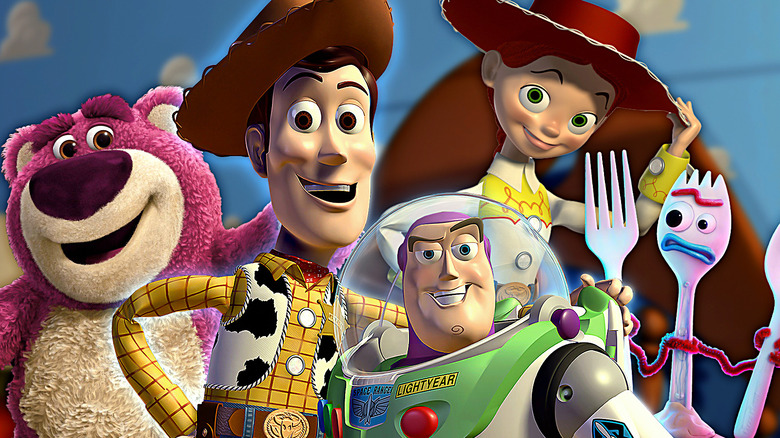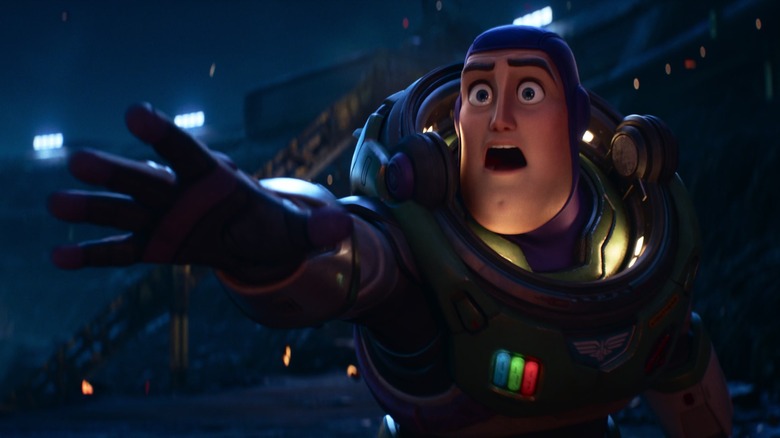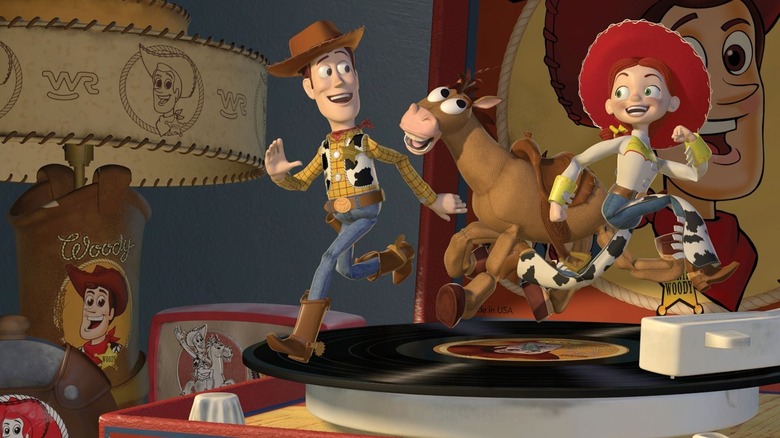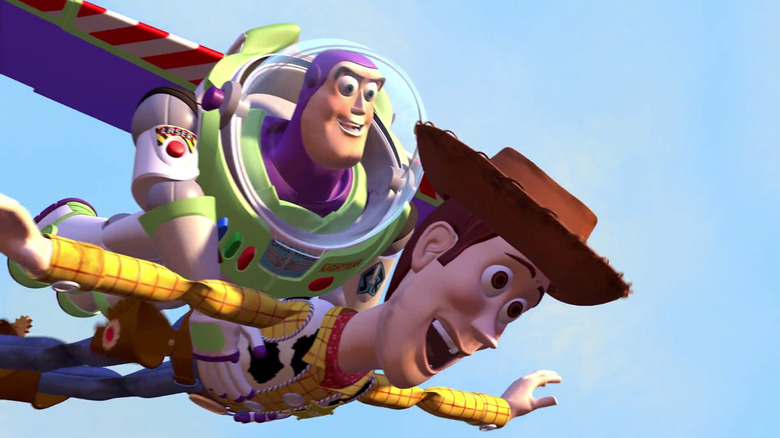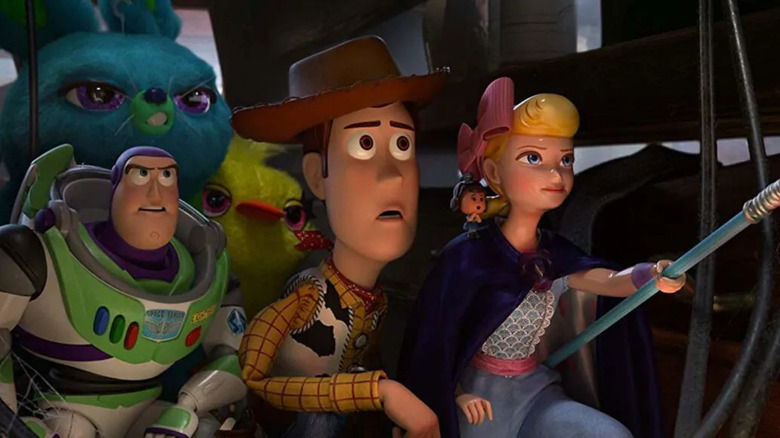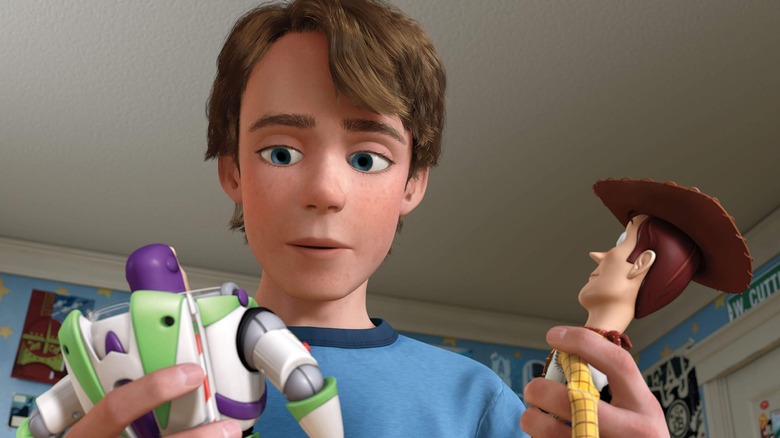Every Toy Story Movie Ranked
This article contains spoilers for the "Toy Story" movies.
When John Lasseter's "Toy Story" was released in 1995, it was a coup for the industry. CGI had been used in films for a decade and there were myriad computer-animated short films, but the first theatrically released, fully-computer-animated feature changed the landscape. It certainly helped that "Toy Story" was a massive success, raking in over $365 million on a mere $30 million budget. The film was also highly acclaimed, sporting a novel concept (your toys are alive when you aren't looking), an excellent screenplay (credited to Joss Whedon, Joel Cohen, Andrew Stanton, and Alec Sokolow), and a first-rate cast (including Tom Hanks, Tim Allen, Don Rickles, Jim Varney, and Wallace Shawn).
After "Toy Story," it felt like the floodgates opened, and a shift from traditionally animated features to fully computer-animated features occurred within the next five years. One might even recall when Disney announced that it would be shuttering its traditional animation studio and only make computer-animated features going forward. This was slightly before its 2004 film "Home on the Range" flopped.
"Toy Story" and Pixar, meanwhile, remained at the head of the charge. In 1998, the studio released "A Bug's Life," which made over $363 million, and its sequel, "Toy Story 2," came out in 1999. Since then, there have been two additional "Toy Story" sequels, with a third on the way. There was also a spinoff featured called "Lightyear," not to mention several short films and TV shows.
For the sake of brevity, the blow list will rank only the five extant theatrical features, although the shorts "Small Fry" and "Partysaurus Rex" are certainly amusing. The spinoff shorts from "Toy Story 4," released as episodes of "Fluffy Stuff with Ducky and Bunny" — called "love" and "Three Heads" — are also rather hysterical. But for now, we shall remain in theaters (and we may have to check back when "Toy Story 5" arrives).
5. Lightyear (2022)
Within the universe of "Toy Story," a young boy named Andy owns a toy called Buzz Lightyear: a futuristic astronaut with a retractable helmet and pop-put jet wings. It's said that Buzz Lightyear was a movie tie-in toy, the plastic version of a live-action space hero. In 2022, Pixar had the clever idea to make the in-universe movie that Andy's toy was based on, and released "Lightyear," a generic space adventure as boring as they come. In "Lightyear," Chris Evans plays the titular hero, an astronaut who accidentally becomes stranded on a distant planet along with a traveling colony of hundreds. Buzz then attempts to rescue the colony by testing faster-than-light engines in orbit, but, thanks to the laws of physics, every four-minute test takes four years on the surface below. As such, Buzz watches close friends age dramatically with every stop to the colony.
The "Star Trek"-ready plot, however, isn't fully explored, and the film eventually gets bogged down with Buzz and a ragtag group of exile trying to defeat a visiting alien marauder called Zurg. The pacing is bad, the action is unexciting, and the titular character isn't even terribly charismatic. If this was the film that inspired young Andy to buy a Buzz Lightyear toy, then the kid has low standards. Also, this film presumably came out in the mid-1990s, yet its filmmakers have no meta-fun with the concept. How cool would it have been if "Lightyear" looked more like, say, "Mighty Morphin Power Rangers: The Movie" (which also came out in 1995)?
More interestingly, Buzz is issued a robotic therapy cat called Sox (Peter Sohn) that can transform and do Buzz's bidding. If I were Andy, I would clamor for a Sox toy before asking for Buzz Lightyear.
4. Toy Story 2 (1999)
"Toy Story 2" follows an interesting thread. The cowboy toy Woody (Tom Hanks) is accidentally put up for purchase in a yard sale, only to be stolen by Al McWhiggin (Wayne Knight), the owner of the Al's Toy Barn store. Audiences learn that Woody isn't just a generic Western action doll, but part of an expanded universe of toys based on a 1950s kids TV show called "Woody's Roundup" — one that includes cowgirl toy Jessie (Joan Cusack), a floppy horse named Bullseye, and a bitter old prospector named Stinky Pete (Kelsey Grammar). Pete, audiences learn, has never been removed from his box, making him a valuable collector's item ... but hollow inside because no children ever played with him.
Woody, fearing that his young owner Andy (John Morris) will no longer want to play with him after Andy inadvertently tears Woody's arm, finds that he's excited to be sold and shipped to a toy museum in Japan with the rest of the "Roundup" gang. Woody's arc is intriguing.
The rest of the film, sadly, is pretty generic. Buzz (Tim Allen) and the remaining toys leave Andy's bedroom to find Woody and stage a rescue, but their shenanigans aren't terribly clever. Even Buzz encountering a second Buzz Lightyear toy (also voiced by Allen) feels like a warmed-up shtick from the first movie. The appearance of Barbie also feels less like a witty addition to the plot and more like a marketing deal finally went through. "Toy Story 2" is certainly far from bad, but it's also the least memorable sequel in the franchise.
3. Toy Story (1995)
This may sound heretical to some, but the first "Toy Story" hasn't aged well. Animation techniques have advanced so much since 1995 that the original "Toy Story" now looks rudimentary, even static and ugly, when compared to the films that followed. And while the characters remain amusing and sharply drawn, and the film's emotional journey remains just as winsome and sentimental, there is an undercurrent of panic and jealousy that gives "Toy Story" a mildly unpleasant note.
"Toy Story" is a family classic, of course, but there are merely a few reasons why it's not at the top of this ranking.
Woody was always Andy's favorite toy, for instance. Because children are capricious, however, Andy stops playing with Woody when he gets a Buzz Lightyear toy as a gift. The shift of Andy's favor from Woody to Buzz also impacts the power dynamic among the toys in his room; there is a leadership structure, and Woody — the favored son — had always been in charge. Woody has to face the fact that he'll be obsolete someday.
The planned obsolescence of toys wouldn't be confronted head-on until "Toy Story 3," so the first film remains a mere tale of professional jealousy, making both Woody and Buzz seem weirdly petty and petulant in some scenes. At least Woody is willing to break the unspoken toy code when confronting a sadistic kid who rips toys apart.
2. Toy Story 4 (2019)
As mentioned above, "Toy Story 3" dealt with the planned obsolescence of toys and featured a scene wherein the main toy characters had to look their mortality right in the eye. Additionally, they had to live with the fact that, as playthings for children, they only have so many years of usefulness before being packed away in the attic or merely thrown into a landfill. "Toy Story 4" seemed like an unnecessary follow-up, as there weren't other adventures a toy could have after something so profound.
Luckily, the makers of "Toy Story 4" found an interesting angle. If a toy becomes lost — left behind at a park, dropped on the sidewalk, abandoned at a truck stop — it's a weirdly freeing experience. Woody, no longer living with Andy, is taken on a road trip by his new owner, a little girl named Bonnie. Bonnie is precocious and makes a new toy out of a spork and pipe cleaners. Forky (Tony Hale), as Bonnie's handmade toy is dubbed, has an identity crisis, still feeling he is disposable cutlery despite having grown a new, rudimentary consciousness. It's a surreal wrinkle in the "Toy Story" series that is welcome and hilarious.
In looking after Forky, Woody becomes lost. His misadventures, however, put him back in the company of Bo Peep (Annie Potts), a toy Andy owned many years ago, but also got lost. By the end of the film, Woody finally realizes that his worth as a toy needn't be attached to a child. He has his voice box removed and decides to live on the road. Watching Woody find happiness on his own is like watching your grandfather retire and move to Bali. He's finally doing something for himself. It's weirdly cathartic.
Also, Ducky and Bunny (Keegan-Michael Key and Jordan Peele) are hilarious.
The fact that Pixar is making a "Toy Story 5" means the studio is tempting fate. It shouldn't have come back for a fourth installment, but luckily made something great. There's no guarantee it can make lightning strike again.
1. Toy Story 3 (2010)
"Toy Story 3" tells two simultaneous tales of mortality. On the one hand, Andy has just turned 18 and no longer has any use for his toys. He will soon move out, so now Woody, Buzz, and all the rest have to face their fate of life in an attic. Or being donated to a daycare. Or being merely thrown away. The toys knew this day was coming, but it's still difficult. "Toy Story 3" has less interest in the merry adventures of living plastic dolls and focuses more on the concept of middle-aged melancholy. There is an underlying sadness to "Toy Story 3" that strengthens it and makes it one of the best films of its year.
Late in the film, after finding their way into a garbage dump, the toys all know their fate is the incinerator. They hold hands, ready to face their deaths. Luckily, they survive ... only to face an even more emotionally harrowing climax. The 18-year-old Andy knows that he can't keep his toys, and, in a heart-aching scene, gives them, one by one, to a little girl named Bonnie, explaining how important they were to him as a child and how they have to live on in her childhood happiness. "This is Woody," Andy says when he hands over his favorite childhood toy, "He's brave." Not a dry eye on the house.
A friend watched this film at the Regent theater in Westwood, California, one of the theaters that is directly next to UCLA. She said that, on opening weekend, the theater was full of 18-year-old college students who likely just went through what Andy did, having to give away or pack up their childhood toys. She said that hundreds of people were audibly bawling. That's the power of "Toy Story 3."
